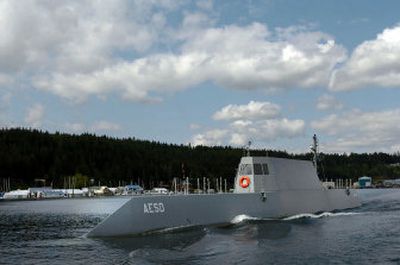Navy test ship plies local waters

BAYVIEW, Idaho – In a movie, only James Bond or a super-villain like Dr. Evil would be at the helm of Sea Jet, a 133-foot stealth destroyer prototype recently launched on Lake Pend Oreille.
Agent Bond or Dr. Evil would keep their futuristic ship moored in a sea cave with a secret door, not anchored next to a busy tourist town marina.
It’s hard not to let the imagination run wild while watching Sea Jet. Although research gained from the ship’s performance will eventually be used to create the next generation of DDX-class destroyers, Sea Jet will have a fairly quiet and entirely peaceful presence on Lake Pend Oreille, said Henry Netzer, director of the U.S. Navy’s Acoustic Research Detachment in Bayview.
The ship will begin conducting regular research cruises on the lake later this month to test its acoustic footprint on the water. The work will involve long hours of test runs above arrays of underwater microphones, Netzer said.
Some of Sea Jet’s features – at least those that can be shared publicly – will eventually be incorporated into the new ships, including a radical new hull design that cuts through the water like a razor and leaves behind little wake for detection by enemy submarines. Sea Jet is propelled by a pair of 400-horsepower, electric-driven Rolls-Royce water jets, which allow the ship to pivot on its centerline and zip around with maneuverability normally limited to bumper cars.
On Friday, Netzer and his crew took the $16 million ship for a spin to show off its capabilities to journalists.
The massive lake was covered with whitecaps, but Sea Jet barely bobbed as it headed out of its Scenic Bay harbor. The ship cruises at 8 knots under diesel power, saving the juice from its 720 batteries for the acoustic test ranges, which are located about 12 miles from Bayview. Under electric power, the ship is almost entirely silent and can run at speeds up to 16 knots, or about 18 mph.
Testing on the ship is expected to last about five years, Netzer said, and will include everything from analyzing the radar signature of its cabin house to the performance of its hull. The first tests, which will begin in the next two weeks, involve measuring the noise created by Sea Jet. Hydrophones suspended some 600 feet below the surface will record sounds created by the ship, sending the data back to the Bayview facility through fiberoptic cables for further analysis.
The ship is being tested on Lake Pend Oreille because it is considered among the world’s most pure acoustical environments, Netzer said. Even with the growing number of pleasure boaters, the lake remains fairly quiet. The ship also does most of its sound testing late at night.
“After sundown, fishermen come off the lake, the winds die down and it gets very quiet,” Netzer explained.
The lake is quiet enough and the hydrophones sensitive enough to pick up the sound of snowflakes and rain hitting the surface. Rockslides on distant, steep shores can become thunderous. Netzer said acoustical engineers can even hear the pinging of passing bull trout that have been implanted with electronic tracking tags.
The massive North Idaho body of water also has its share of lake-monster folklore, including sea serpents and the legendary Lake Pend Oreille “paddler” monster, which is reputed to have fins and a horn-crested head. Cmdr. Dave Kohnke, the officer in charge of the Bayview facility, began hearing the monster stories the day he arrived two years ago. He laughed when they were mentioned Friday, but didn’t give a direct answer.
“I can’t confirm any of those rumors,” Kohnke said.
If there are lake monsters, the ship would be defenseless. No weapons are carried on the Sea Jet, Netzer said. The only ancillary equipment aboard the ship appeared to be a coffee pot and small microwave.
During its eight- to 12-hour shifts on the lake, Sea Jet is crewed by a pilot, an engineer and two or more sound technicians. The ship operates under the same navigational laws that apply to pleasure boaters. It’s not illegal to approach the ship for a glimpse, so long as safe distances are maintained, Netzer said.
“We’ll let you know if we want you out of the way,” he said.
Until Sea Jet’s recent christening, the Bayview facility was devoted to testing submarine technology. Work continues on the subs. Later this year the facility will also begin testing buoyant vehicles, which are scale models of submarines winched to the bottom of Lake Pend Oreille. When they’re released, the vehicles float silently to the surface and sound measurements are taken of the water whooshing past the hull. The data will help design new, super-silent sub hulls.
For now, most of the attention is being focused on Sea Jet. The ship has undergone rigorous testing to ensure its unusual hull design and propulsion system are safe on the lake, Kohnke said. Already it has performed seamlessly during 16 consecutive days of operation, including cruises when waves reached three feet.
“Everyone’s been pleasantly surprised by both its stability and reliability,” Kohnke said.